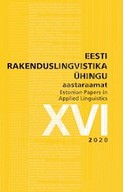SIHTKEELE KULTUURIRUUMIST LÄHTUVA IDENTITEEDI KASUTAMINE ALGTASEME VÕÕRKEELEÕPPES
THE USE OF TARGET-CULTURE-INSPIRED IDENTITY IN FOREIGN LANGUAGE CLASSROOM FOR BEGINNERS
Author(s): Katrin Koorits, Merje MilisteSubject(s): Foreign languages learning, Language acquisition, School education, Higher Education
Published by: Eesti Rakenduslingvistika Ühing (ERÜ)
Keywords: language learning and teaching; language acqusition; engagement of learners; intensive course; discovery learning; German language;
Summary/Abstract: Estonia has been known in many areas of life due to its innovative approaches; nevertheless, traditional methods are mainly used for teaching foreign languages at our schools and universities. As a result of this traditional approach, language learners know grammar and vocabulary quite well, but they lack in communicative skills. University students are used to studying foreign languages in a classical and so-to-say safe way, which means mainly reading and translating coursebook texts, completing blank-filling exercises etc. As a result, the learners assume quite a passive role and they are made to solve pre-set exercises. This situation does not support creativity, learner autonomy and discovery learning. A two-semester action research study was conducted at the University of Tartu in the academic year 2017/2018. The research project was based on the intensive course of German for beginners, within which each student was asked to create for themselves a new target-culture-inspired identity. This approach was used in order to increase the students’ communicative competence in the foreign language, raise their motivation and introduce a slightly different, playful way of studying a foreign language. Elements of discovery learning and drama in education as well as various technological solutions (e-support, e-portfolio) were used in the course to increase the level of student involvement. The thematic analysis of students’ e-portfolios has shown that the change of identity was motivating, helping to create a stress-free study environment, encouraging the development of participants’ creativity and communicative competence. The change of student identity in a foreign language classroom is likely to lead to efficient and varied foreign language learning and helps the language learner to understand the target language culture better.
Journal: Eesti Rakenduslingvistika Ühingu aastaraamat
- Issue Year: 2020
- Issue No: 16
- Page Range: 109-124
- Page Count: 16
- Language: Estonian

